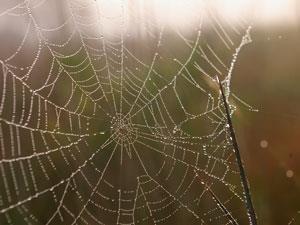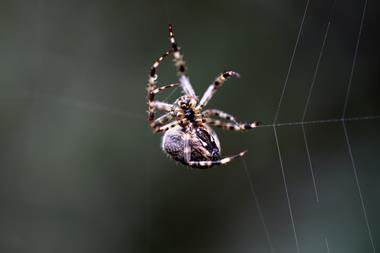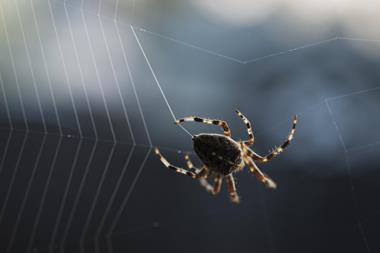Mimicking silk protein’s stimuli responsiveness not only brings millimetre-scale cracks together, it also successfully recreates its legendary toughness
US and Hong Kong scientists have invented
a material that can heal itself from millimetre-scale cracks when heated, using spider-silk inspired plastic threads. In composites made by
Guoqiang Li from Louisiana State University and his team, the threads draw cracks closed before plastic particles melt into the crack. Thanks in part to their threads being tougher than Kevlar, the scientists were able to restore materials with 3mm wide cracks to 94% of their original strength. ‘We’re targeting lightweight moving structures in aerospace and transportation, where dynamic forces and impacts can cause cracking,’ Li tells
Chemistry World. ‘In these applications,
self-healing capabilities are badly needed.’
Researchers have already developed composites that are able to heal microscopic cracks, but it’s hard to include enough repair material to close larger cracks in this way. Li realised that, like human wounds, such large gashes must be closed before healing. He wanted to do this by embedding threads through the composite that would contract on demand. Li knew this was possible because spider silk contracts in response to humidity. But rather than farm spiders for their silk, Li’s team span polyurethane shape memory polymers into threads.
Spider silk protein, fibroin, features soft domains containing repeated alanine blocks embedded into harder domains containing repeated glycine blocks. The interplay between these blocks gives spider silk both humidity response and remarkable strength. To make their threads Li, his Louisiana State colleague Harper Meng, and Jinlian Hu from the Hong Kong Polytechnic University in Kowloon used polymers that also feature hard and soft regions.

Stretching the stimuli-responsive threads (SRTs) when cold lengthens the soft and part of the hard regions, Li explains, ‘When you heat the SRT, the soft and hard segments of the SRT have enough mobility to relax, which causes its shape recovery,’ he says. This happens at a lower temperature than the thermoplastic particles’ melting point, drawing the crack together before it’s sealed. And while other researchers have struggled to recreate spider silk’s tough, stretchy, properties, this new procedure raises the SRTs’ properties above this natural benchmark. ‘Our team has shown that cold drawing processes can align more molecules along the loading direction to make it stronger,’ he says.
David Haddleton, who researches self-healing materials at the University of Warwick, UK, calls the fact that the self-healing mechanism is so close to human wound healing ‘fascinating’. ‘The mechanical strength of these self-healing materials is quite remarkable, especially when compared to materials such as Kevlar and carbon fibre,’ he adds.










No comments yet